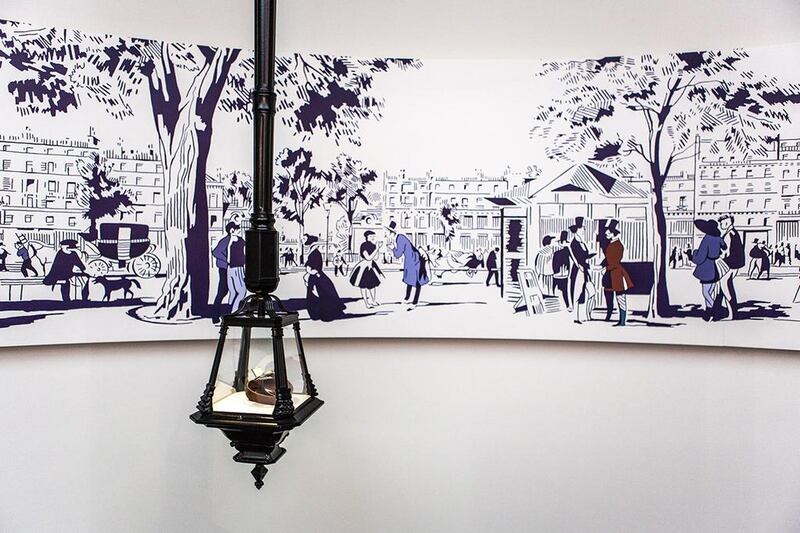'Flânerie is the elegant way to lose one's time," says Hubert Le Gall, the scenographer behind Hermès Wanderland, an exhibition being held at The Dubai Fountains until February 7.
Beloved of 19th-century French dandies, flânerie was once deemed an essential part of being a gentleman. With no direct English translation, it is, in essence, the art of the aimless stroll, of being curious yet idle.
The vague but precise nature of this charming concept is reflected in the title of the exhibition, Wanderland. This is not about wondering (as in enquiring) but about wandering (as in moving freely). Coming from Hermès, which is known for its intense attention to detail, this is an important distinction.
Flânerie is a term that might well apply to the man considered as the founding force of modern-day Hermès. Emile-Maurice Hermès was the grandson of the founder, and took over the company with his brother in the early 1900s. After briefly changing the brand's name to Hermès Frères, he soon went it alone, restoring the original name. A traveller, entrepreneur and innovator, Emile-Maurice was regarded as a creative eccentric, known for his curious mind and love of collecting. Fascinated with trinkets, new ideas and other cultures, he avidly acquired pieces from around the world, storing them away and later distilling them into inspiration for his company.
Possessed by an insatiable curiosity, it was Emile-Maurice who acquired the French patent for the zip, introducing it to France, where for many years it was known as the Hermès fastening. He was the first in France to use the zip on clothing, when he created a golf jacket for the Prince of Wales, which, incidentally, was the first-ever item of Hermès clothing.
Emile-Maurice was also behind the Hermès scarf, launching a worldwide fascination with the printed silk squares that endures to this day, with an Hermès scarf now reportedly sold every 20 seconds.
"Emile Hermès was, for me, the incarnation of the flâneur," says Le Gall.
Shunning the word "luxury" in favour of the word "refinement", Hermès has guarded this legacy. The company stands by the claim that, to this day, every Hermès item is handmade by a single artisan. It has totally shunned mass-production techniques. Although time-consuming and costly, many of its processes have hardly changed through the ages.
Such is the quality of the company's pieces that it hardly seems surprising that a recent report in The Guardian listed the iconic Hermès Birkin bag as a better investment than gold, with an average yearly return of 14.2 per cent, according to Baghunter.com.
It is this heritage and unwavering commitment to quality that is being highlighted in Wanderland. Curated by Bruno Gaduichon of La Piscine-Musée d'Art et d'Industrie in Roubaix, who collaborated with the artist Le Gall, the unique touring exhibition was first shown in London at the Saatchi Gallery, before moving to Paris, where it was housed on the banks of the Seine. In a major coup, Dubai has become its third stop, and next on the list is Seoul in South Korea. The next destination after that is a closely guarded secret, but is rumoured to be Shanghai.
Described as an "immersive exhibition", Wanderland, which is free to enter, offers a rare opportunity to get up close and personal with the pathologically discreet French fashion giant. As curator, Gaduichon was granted full access to the private museum of Emile-Maurice Hermès, situated above the brand's flagship store at 24 Rue du Faubourg Saint-Honoré, to gather some of the 30,000 objects on display.
Eight artists were brought on board to help realise the vision of Gaduichon and Le Gall, including the digital artist Nicolas Tourte. There are local elements to each show, too. In Paris, the graffiti artist Sept created a piece, while in Dubai, local graffiti artist Khalid Mezaina was tasked with creating a live artwork for the opening.
“My inspiration was a surrealistic vision of Paris, which enabled me to play and make distortions with space and time,” Le Gall explains. “The architecture of Paris is full of history, but Paris is also changing every day, and my idea was to mix the past, and the current and present creativity that transforms the town and makes it keep its eternal identity.”
Ranging from pieces first collected by Emile-Maurice to vintage Hermès creations, the real surprise is perhaps not in the items on show, but the way in which they are displayed. There are no stuffy cabinets filled with endless labelled objects; the visitor is instead taken on a slightly surreal journey through 11 rooms.
Invited to stroll at leisure – to become a flâneur – you are taken on an extraordinary trip that passes from a room decorated entirely in canes (yet another famous Hermès item), and whose only exit is via a wardrobe (bringing back childlike memories for anyone who read The Lion, The Witch and the Wardrobe), through to a cafe, complete with a street scene, chairs and tables, called simply The Café of Forgotten Objects.
A 19th-century Parisian street, with a tiled floor and covered roof, is flanked by inviting shopfronts. But the windows aren’t brimming with things for sale; they consist instead of eccentric scenes. A giant elephant sculpture lies squashed into the window of one shop, surrounded by upturned chinaware, while in another, gleaming leather saddles rest quietly on floor lamps. Elsewhere, a glitter ball is the only illumination in a room where a looping film of a dancer twirling vintage canes sweeps across the walls. And a horse’s head sits mounted on a wall, its Pegasus wings decorated with flippers, tennis rackets and golf clubs.
Why? Why not, seems to be the only answer.
smaisey@thenational.ae





